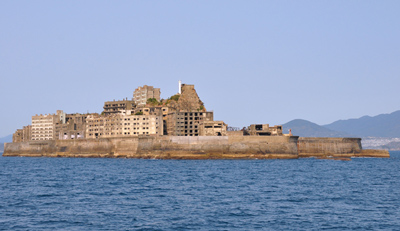The first time I participated in haikyo was entirely by accident. My husband and I were cycling in the shadow of Mt. Fuji when we stumbled across an empty and dilapidated hotel on the shoreline of Lake Kawaguchiko. It struck us as unusual that the remains of this building were completely open to the elements. In other countries we had traveled through, disused buildings and structures were largely boarded up and made inaccessible. So this particular abandoned hotel, with its easy access and its obvious regression back to nature, stuck out like a sore thumb. We were drawn into it like moths to a flame.
We entered the hotel, although any semblance of an entrance had long since fallen apart. In fact, the entire front wall of the hotel no longer existed, and what would have been the lobby was now an open-air skeleton of a room. We wandered around the lower levels of the old hotel with a sense of awe and excitement. It was amazing that something like this not only existed, but also could give us an instant, albeit fuzzy, snapshot of a bygone era. Part of the fun also came in trying to figure out why and when this place had gone bust.
 Surveying the scene and all of its contents, which included bulky Sanyo television sets, fax machines the size of photocopiers, and magazine scraps, it appeared as though the hotel had closed its doors during the early 1990s—a consequence of Japan’s ‘bubble’ economy bursting perhaps? Although I am sure the fact that it was the only hotel whose view of Mt. Fuji was obscured by a large pine plantation didn’t do much for business either! Further exploration of the first floor showed tea cups set out ready for use in what we guessed must have previously been the lobby bar, and a kitchen area with a fridge hanging wide during a sneaky midnight feed. A deso- late reception area had forms laid out waiting for the arrival of guests that never came. It all seemed quite hopeless.
Surveying the scene and all of its contents, which included bulky Sanyo television sets, fax machines the size of photocopiers, and magazine scraps, it appeared as though the hotel had closed its doors during the early 1990s—a consequence of Japan’s ‘bubble’ economy bursting perhaps? Although I am sure the fact that it was the only hotel whose view of Mt. Fuji was obscured by a large pine plantation didn’t do much for business either! Further exploration of the first floor showed tea cups set out ready for use in what we guessed must have previously been the lobby bar, and a kitchen area with a fridge hanging wide during a sneaky midnight feed. A deso- late reception area had forms laid out waiting for the arrival of guests that never came. It all seemed quite hopeless.
Yet strangely, there was a sense of calm about standing in a space that was slowly and surely being reclaimed by nature. In a country that has prided itself on the rate in which it has moved on and pushed forward since the end of World War II, it was incredible to be in a part of Japan that seemed to be standing still.
Literally translated as ‘ruins,’ haikyo, or urban exploring as it is also called, is slowly finding its way into the mainstream as an active hobby for those looking to do something with an adventure component. With its popularity amongst both for- eigners and Japanese on the rise, a new term has even been coined to describe those who haikyo or urban explore on a regular basis: ‘haikyo- ists’ or, for those outside of Japan, ‘urbexers.’
 “I’ve always been interested in ruins, ever since seeing movies like Goonies and Indiana Jones as a kid,” says Michael John Grist, who lives in Tokyo and has been going on haikyo expeditions for around three years now. “I did a few haikyo in Japan by happenstance in my early years here—places that I had stumbled across and thought I would check out. One was an apartment block and one an old air base.” Not long after, an article on haikyo caught his eye, and now Grist heads out on an expedition once every few weeks.
“I’ve always been interested in ruins, ever since seeing movies like Goonies and Indiana Jones as a kid,” says Michael John Grist, who lives in Tokyo and has been going on haikyo expeditions for around three years now. “I did a few haikyo in Japan by happenstance in my early years here—places that I had stumbled across and thought I would check out. One was an apartment block and one an old air base.” Not long after, an article on haikyo caught his eye, and now Grist heads out on an expedition once every few weeks.
For Florian, a Kansai-based haikyoist, studying history kick-started his interest in exploring industrial ruins. Looking to blogs, online maps, magazine articles and books, he completed his first haikyo only six months ago, but now heads out on such expeditions as often as he can. “It has strengthened my interest in Japanese history,” says Florian. “Haikyo to me is a part of social history, as it allows a glimpse of how people lived or worked in past times.”
Yet up until recently, before the low birth rate and the aging population started wreaking havoc on Japan’s inhab- itants, population and where to put that population was such an issue that in some areas, the government began to reclaim land from the sea. So why are abandoned places left relatively untouched in a place where space is so hard to come by?
“In a country that has prided itself on the rate in which it has moved on and pushed forward since the end of World War II, it was incredible to bein a part of Japan that seemed to be standing still.”
Grist supports a notion discussed by Alex Kerr in his 2001 novel Dogs and Demons, which states that it is an “after-effect of the 80s bubble economy, which was built around real estate.”
 “The [property] was a toxic asset,” Grist explains, “and doing anything with it all, [whether it was] reworking, selling, or buying, would be to sink further money into a black hole.” Essentially, the property is worth more as is—meaning on paper—than it would be to get rid of or do anything with it. And as a result, haikyo has not only been enabled, but locations for such expeditions have proliferated the Japanese countryside. This is, of course, good news for haikyoists.
“The [property] was a toxic asset,” Grist explains, “and doing anything with it all, [whether it was] reworking, selling, or buying, would be to sink further money into a black hole.” Essentially, the property is worth more as is—meaning on paper—than it would be to get rid of or do anything with it. And as a result, haikyo has not only been enabled, but locations for such expeditions have proliferated the Japanese countryside. This is, of course, good news for haikyoists.
Grist has explored a range of sites around Tokyo and Japan, including capsule and love hotels, hospitals, museums, the ruins of a kaiten suicide boat base, and the Kawaminami POW Shipyard. He has parlayed this hobby into a fantastic website (see sidebar on p18), where he shares his photographs and site descriptions with readers from around the world.
Glossary:
Haikyo: While it literally translates into ‘ruins,’ as a verb it means to explore ruins and abandoned places.
Urban Exploration: The exploration of haikyo and other abandoned sites, as well as places people are not supposed to go, whether they are abandoned or not.
Haikyoist/Urbexer: A person who regularly undertakes haikyo or urban exploration.
“One of the strangest ruins I found was an underground bunker with two high security vaults inside,” reveals Grist. “The doors were hanging open and I was able to go inside. Hanging on the wall were five curious icons that looked at once mysterious and cultish.” Grist goes on to say that while people theorized on his website as to what the symbols meant, it was only after a fellow haikyoist went there and had his account published in a magazine article that the mystery was solved. “We [learned] that it was a vault belonging to a famous Japanese securities company that went under in the bubble. The mystery was very exciting for a time though.”
 Florian has also had the chance to venture to a wide range of haikyo sites, with the Katashima Training School perhaps being one of the most intriguing, as it was basically a training ground for suicide terrorist attacks. “Hardly anybody knows that the Japanese military had a thing for self destructing soldiers,” Florian writes on his website, Abandoned Kansai (see sidebar on p18). “They blew up their own people not only in airplanes, but in mini-submarines, speed boats, and as divers with mines on top of a five-meter-long bamboo stick.” However, as exciting as navigating these kinds of sites can be, a haikyoist must always remember that when it comes down to it, they should not be there. When asked about the legalities of entering these properties, Grist answers that “in some cases it probably is trespassing. I’m no expert [on the law], but I know it is at least frowned upon.”
Florian has also had the chance to venture to a wide range of haikyo sites, with the Katashima Training School perhaps being one of the most intriguing, as it was basically a training ground for suicide terrorist attacks. “Hardly anybody knows that the Japanese military had a thing for self destructing soldiers,” Florian writes on his website, Abandoned Kansai (see sidebar on p18). “They blew up their own people not only in airplanes, but in mini-submarines, speed boats, and as divers with mines on top of a five-meter-long bamboo stick.” However, as exciting as navigating these kinds of sites can be, a haikyoist must always remember that when it comes down to it, they should not be there. When asked about the legalities of entering these properties, Grist answers that “in some cases it probably is trespassing. I’m no expert [on the law], but I know it is at least frowned upon.”
For those interested in haikyo, there is plenty of information in print and online to help get started, including finding locations and how to get there. For example:
Michael John Grist has been undertaking regular haikyo expeditions for over three years and shares his experiences and photographs at www.michaeljohngrist.com.
Florian has been navigating haikyo around Japan for about six months. He talks about his adventures and posts photos of his experiences at http://abandonedkansai.wordpress.com.
Florian agrees that it is technically trespassing. “If you take something it is theft, and if you break something, even by accident, it is vandalism. If you break something while entering then it is burglary. It doesn’t matter that the place is abandoned.”
And both Grist and Florian stress that they, as with most haikyoists, are not in it for any buzz, nor do they gain any thrill from being somewhere they shouldn’t. “I am just in it for the ruins,” Grist elaborates. “The [security] protecting some of the places is doing it more for [the owner’s] liability in case somebody like me gets inured inside.”
Other than running into the odd security guard who may ask haikyoists to leave—and the best advice is to respect those directives—both Grist and Florian state that using common sense is the most important thing when undertaking such an expedition. Budding haikyoists should remember to have a good look at the area they want to explore from the outside first, checking for security measures, barbed wire and other people to make sure it is really abandoned, before proceeding with caution.
 “The biggest risks are from unsafe floors and railings,” says Grist. He also warns, as strange as it may seem, that concrete can—and does—rot through. It is also important to follow the hai- kyoist/urbexer’s general rule: take only photos, leave only foot- prints.
“The biggest risks are from unsafe floors and railings,” says Grist. He also warns, as strange as it may seem, that concrete can—and does—rot through. It is also important to follow the hai- kyoist/urbexer’s general rule: take only photos, leave only foot- prints.
I think back to that desolate hotel underneath Mt. Fuji. The questions about what went before are endless: Who owned it? What became of them? Do they still think about their place on the lake? Who holidayed there? In some ways, haikyo demonstrates that one person’s trash really is another’s treasure. It also shows that the life of a building or structure does not end with the finishing of construction, or even occupancy. In fact, some might say that this is when life really begins: through an old door leading to a new world waiting to be discovered. This is pretty rare in a country where virtually no stone has been left unturned.
Photos by Florian (photos one to three) and John Grist (four to six)
External Link:
Haikyo, Japan









